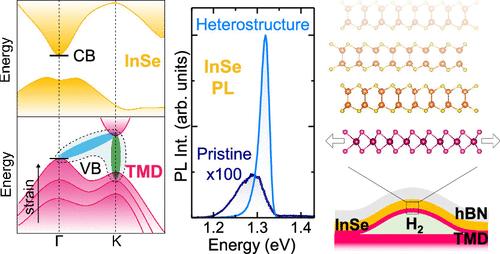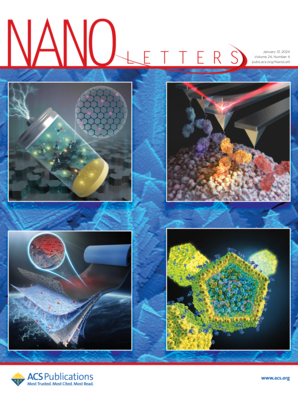Giant Light Emission Enhancement in Strain-Engineered InSe/MS2 (M = Mo or W) van der Waals Heterostructures
IF 9.1
1区 材料科学
Q1 CHEMISTRY, MULTIDISCIPLINARY
引用次数: 0
Abstract
Two-dimensional (2D) heterostructures (HSs) offer unlimited possibilities for playing with layer number, order, and twist angle. The realization of high-performance optoelectronic devices, however, requires the achievement of specific band alignments, k-space matching between conduction and valence band extrema, and efficient charge transfer between the constituent layers. Fine-tuning mechanisms to design ideal HSs are lacking. Here, we show that layer-selective strain engineering can be exploited as an extra degree of freedom to tailor the band alignment and optical properties of 2D HSs. To that end, strain is selectively applied to MS2 (M = Mo or W) monolayers in InSe/MS2 HSs, triggering a giant photoluminescence enhancement of the highly tunable but weakly emitting InSe of up to >2 orders of magnitude. Resonant excitation measurements, supported by first-principles calculations, provide evidence of a strain-activated charge transfer from the MS2 monolayers toward InSe. The huge emission enhancement of InSe widens its range of applications for optoelectronics.

应变工程InSe/MS2 (M = Mo或W)范德华异质结构的巨光发射增强
二维(2D)异质结构(hs)提供了无限的可能性来发挥层数,顺序和扭转角度。然而,高性能光电器件的实现需要实现特定的能带对准、导价带极值之间的k空间匹配以及组成层之间的有效电荷转移。目前还缺乏设计理想高速路的微调机制。在这里,我们展示了层选择应变工程可以作为一个额外的自由度来定制二维高分辨率的波段对准和光学特性。为此,将应变选择性地施加于InSe/MS2 HSs中的MS2 (M = Mo或W)单层,触发高度可调谐但弱发射的InSe的巨大光致发光增强,增强幅度高达2个数量级。在第一性原理计算的支持下,共振激发测量提供了应变激活电荷从MS2单层向InSe转移的证据。铟硒巨大的发射增强特性拓宽了其在光电子领域的应用范围。
本文章由计算机程序翻译,如有差异,请以英文原文为准。
求助全文
约1分钟内获得全文
求助全文
来源期刊

Nano Letters
工程技术-材料科学:综合
CiteScore
16.80
自引率
2.80%
发文量
1182
审稿时长
1.4 months
期刊介绍:
Nano Letters serves as a dynamic platform for promptly disseminating original results in fundamental, applied, and emerging research across all facets of nanoscience and nanotechnology. A pivotal criterion for inclusion within Nano Letters is the convergence of at least two different areas or disciplines, ensuring a rich interdisciplinary scope. The journal is dedicated to fostering exploration in diverse areas, including:
- Experimental and theoretical findings on physical, chemical, and biological phenomena at the nanoscale
- Synthesis, characterization, and processing of organic, inorganic, polymer, and hybrid nanomaterials through physical, chemical, and biological methodologies
- Modeling and simulation of synthetic, assembly, and interaction processes
- Realization of integrated nanostructures and nano-engineered devices exhibiting advanced performance
- Applications of nanoscale materials in living and environmental systems
Nano Letters is committed to advancing and showcasing groundbreaking research that intersects various domains, fostering innovation and collaboration in the ever-evolving field of nanoscience and nanotechnology.
 求助内容:
求助内容: 应助结果提醒方式:
应助结果提醒方式:


